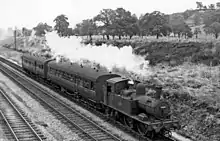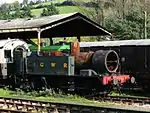GWR 1400 Class
The GWR 1400 Class is a class of steam locomotive designed by the Great Western Railway for branch line passenger work. It was originally classified as the 4800 Class when introduced in 1932, and renumbered in 1946.
| GWR 4800 class (later 1400 class) | |||||||||||||||||||||||||||||||||||||||||||||||||||||||||||
|---|---|---|---|---|---|---|---|---|---|---|---|---|---|---|---|---|---|---|---|---|---|---|---|---|---|---|---|---|---|---|---|---|---|---|---|---|---|---|---|---|---|---|---|---|---|---|---|---|---|---|---|---|---|---|---|---|---|---|---|
 1445 freshly painted at Swindon Works in 1950 | |||||||||||||||||||||||||||||||||||||||||||||||||||||||||||
| |||||||||||||||||||||||||||||||||||||||||||||||||||||||||||
| |||||||||||||||||||||||||||||||||||||||||||||||||||||||||||
| |||||||||||||||||||||||||||||||||||||||||||||||||||||||||||
| |||||||||||||||||||||||||||||||||||||||||||||||||||||||||||
Although credited to Charles Collett, the design dated back to 1868 with the introduction of the George Armstrong 517 class.
Precursors
Like the 48xx/14xx, the 517 Class was a lightweight loco for branchline work; it was built at Wolverhampton Works between 1868 and 1885.
In this period evolutionary changes included:
- 517-570 – with 13 ft 7 in (4.14 m) wheelbase, inside bearings to trailing wheels, and saddle tanks built 1868-1869.
- 571-576 – with 13 ft 7 in (4.14 m) wheelbase, outside bearings and side tanks built 1869-1870
- 826-836, 838-849, 1154–1165, 202-05, 215-222, 1421–1432, 1433–1444, 1465-1482 – all with 15 ft 0 in (4.57 m) wheelbase with side tanks built 1873-1883
- 1483-1488 – with 15 ft 6 in (4.72 m) wheelbase and side tanks built 1884-1885
Later gradual changes included: Belpaire fireboxes, boilers rated at 165 psi (1.14 MPa) as opposed to 150 psi (1.0 MPa), full cabs, extended bunkers and the progressive conversion of short wheelbase locos to 15 ft 0 in (4.57 m) or 15 ft 6 in (4.72 m). From 1924 onwards, several were converted to run with an autocoach, and in this configuration were the direct ancestors of the 48xx class.
In this form, the updated 517s were but a small step away from the 48xx. The wheelbase was still 15 ft 6 in (4.72 m), the boiler still rated at only 165 psi (1.14 MPa), and the wheels 5 ft 2 in (1,575 mm) and 3 ft 8 in (1,118 mm). New was the Collett-style cab and bunker and the boiler nominally to a new design. A three bar crosshead was added to the motion. This was a 1924 innovation introduced with the GWR 5600 Class and also seen in the 1930s-built 5400, 6400 and 7400 classes of pannier tanks.
Into service

The 4800 Class was designed as a more modern version of the 517 Class, which were by then beginning to show their relative age. The first locomotive, No 4800, was built by Swindon Works and entered service in 1932, with a further seventy-four engines of this type following up to 1936. During this period, Swindon also built twenty 5800 Class engines, which were broadly similar but which were not fitted with autotrain equipment or the Swindon top feed as later fitted to a number of 4800 class engines.
The 4800 Class locomotives retained their original numbers until the GWR decided to experimentally convert twelve 2800 Class 2-8-0s for oil-firing. It was decided that the converted engines would be reclassified as the 4800 Class and so the 75 tank locomotives already carrying this designation were reclassified as the 1400 Class with running numbers 1400-1474. The engines did not revert to their original classification after the experiment ended in 1948. They could reach a maximum speed of 80 mph (130 km/h) which was much faster than the diesel railcars designed to replace them could reach.[2]
The 1400 Class was designed to work with the GWR design of autocoach, a specialist coach designed for push-pull working and which could also be used with engines of other classes such as the 517s, the GWR 5400 Class, the GWR 6400 Class and the older GWR 2021 Class. This lack of auto gear was the cause of earlier scrapping of the 5800 Class as there was no work for them. The last, no. 5815, was withdrawn from Swindon shed in April 1961.[3]
The auto-fitted locos fared little better; scrapping commenced in 1956 and all were withdrawn by early 1965. Nos. 1442 and 1450 were withdrawn from Exmouth Junction shed in May 1965.[4] By the early 1960s several had been in store (parked in an out-of-the-way siding with a tarpaulin over the chimney) for some time, being occasionally steamed to replace failed diesels.
| Year | Quantity | Lot No. | Locomotive numbers | Notes |
|---|---|---|---|---|
| 1932–33 | 30 | 279 | 4800–4829 | renumbered 1400–1429 in 1946 |
| 1934–35 | 30 | 288 | 4830–4859 | renumbered 1430–1459 in 1946 |
| 1936 | 15 | 287 | 4860–4874 | renumbered 1460–1474 in 1946 |
Preservation

Four examples have been preserved, all late withdrawals from service in the 1963-1965 period. All went direct to preservation from British Railways in relatively good condition.
Loco numbers in bold mean their current number.
| Number | Built | Withdrawn | Service Life | Location | Owners | Livery | Condition | Mainline Certified | Photograph | Notes | |
|---|---|---|---|---|---|---|---|---|---|---|---|
| GWR | GWR (1946) | ||||||||||
| 4820 | 1420 | Nov. 1933 | Nov. 1964 | 31 Years | South Devon Railway | South Devon Railway Association | GWR Green | Undergoing overhaul | No |  |
Has carried the name Bulliver in preservation; "Bulliver" was the local name given to the Ashburton branch line train (which used the route of the present South Devon Railway).[6] |
| 4842 | 1442 | Apr. 1935 | May 1965 | 30 Years, 1 month | Tiverton, Devon | Tiverton Museum | GWR Green | Static exhibit | No | .jpg.webp) |
Was displayed in the open air at Blundell's Road until 1978 when it was moved to its present location. |
| 4850 | 1450 | Jul. 1935 | May 1965 | 29 Years, 10 months | Severn Valley Railway | Privately owned | GWR Green | Stored[7] | Formerly |  |
Formerly owned by the Dart Valley (later South Devon) Railway. In 1991 it was sold to present owner Mike Little who formed Pull Push Ltd. to manage its operation. Has resided on the SVR since 2014 when it was moved from the Dean Forest Railway. |
| 4866 | 1466 | Feb. 1936 | Dec. 1963 | 27 Years, 10 months | Didcot Railway Centre | Great Western Society | BR Black | Undergoing overhaul | No |  |
Was the first example to be preserved, being sold to the GWS for £750 in April 1964.[8] |
1442 spent its last years working between Tiverton and Tiverton Junction and became known as Tivvy Bumper. It was purchased by Lord Amory in 1965 for display at Tiverton.[9] All preserved examples apart from 1442 are fitted with auto train equipment, and 1450 has also operated on the mainline in preservation, but due to its size was restricted in the amount of work it could do and was also restricted on mileage, as the 1400s only have a max water capacity of 800 imp gal (3,600 L; 960 US gal). During the 1990s it worked a number of Dawlish Donkey trips from Exeter St Davids to Newton Abbot.
In fiction
- During the 1952 production of the Ealing comedy The Titfield Thunderbolt, 14xx locomotives Nos. 1401 and 1456 (doubling as 1401) were specially assigned to the film shoot, which took place primarily in the Limpley Stoke area. For this, the locomotives were temporarily allocated to Westbury locomotive depot.[10]
- Oliver, in The Railway Series and its adaptation Thomas & Friends, is a member of this class.[11] He carries a brakevan named Toad.[12]
Models
- Airfix introduced a model of the 14xx in OO gauge in 1978.
- Hornby Railways manufacture a model of the 14xx in OO gauge.
- Dapol manufactured a model of the 14xx for British N gauge in 2004 but has since ended production of this model.
- DJmodels produced models of the 14xx, 58xx and 48xx class locomotives in 00 gauge in 2018.[13][14]
- Dapol released a version of the 14xx in O gauge in early 2020.[15]
References
- Champ (2018), p. 319.
- Speller, John. "Collett Locomotives". John Speller's Web Pages. Archived from the original on 22 October 2020. Retrieved 25 June 2020.
- Rowledge (1986), p. 135.
- Rowledge (1986), p. 123.
- Allcock et al. (1968), pp. 36–37.
- "Bulliver". South Devon Railway. Retrieved 11 March 2022.
- "1450 bows out as sister engines overhauls make good headway". The Railway Magazine. No. 1438. January 2021. p. 60.
- "1466/4866-48XX/14XX Class". Didcot Railway Centre. Retrieved 11 March 2022.
- "1442 - Preserved British Steam Locomotives". Retrieved 21 December 2021.
- Castens, Simon (2018). On the Trail of The Titfield Thunderbolt. Bath: Thunderbolt Books. ISBN 978-1-912038-99-2.
- Awdry, Wilbert Vere. The Island of Sodor, Its People, History and Railways. p. 132.
- "Oliver - Character Profile & Bio Thomas & Friends". Gullane (Thomas) Ltd. Archived from the original on 27 June 2017. Retrieved 27 June 2017.
- Mylett, David (15 June 2016). "Hattons Exclusive 14xx 2nd EPs arrive". Hattons Model Railways.
- Mylett, David (24 June 2016). "2nd Batch of colour samples for 14xx". Hattons Model Railways.
- "Welcome to Tower Models Website". Tower Models. Retrieved 6 September 2017.
- Allcock, N. J.; Davies, F. K.; le Fleming, H. M.; Maskelyne, J. N.; Reed, P. J. T.; Tabor, F. J. (1968) [1951]. White, D. E. (ed.). The Locomotives of the Great Western Railway, part one: Preliminary Survey. Kenilworth: RCTS.
- Champ, Jim (2018). An Introduction to Great Western Locomotive Development. Barnsley: Pen & Sword Transport. ISBN 978-1-4738-7784-9. OCLC 1029234106. OL 26953051M.
- Rowledge, J.W.P. (1986). GWR Locomotive Allocations: First and Last Sheds 1922-1967. Newton Abbot: David & Charles. ISBN 0-7153-8820-7.
- Whitehurst, Brian (1973). Great Western Engines, Names, Numbers, Types and Classes (1940 to Preservation). Oxford, UK: Oxford Publishing Company. pp. 17–18, 97, 102, 166. ISBN 978-0-9028-8821-0. OCLC 815661.
External links
- The Great Western Archive – 1400 class
- South Devon Railway - Details of no. 1420 (includes drawing and specifications)
- GWR 14xx Class - Past & Present (includes operating history of the preserved examples)